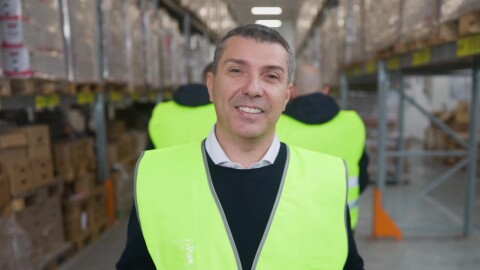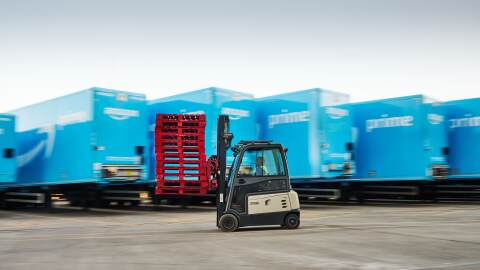Amazon has today published a new, open-source tool, CHALET, to help private industry, governments, electricity network operators, and local authorities determine where electric charging points for heavy goods vehicles should be built. Identifying where charging infrastructure should be built is one of the most pressing challenges facing the transportation industry in its efforts to decarbonise, and tools like CHALET could help accelerate the pace of logistics decarbonisation in Europe.
CHALET, which stands for Charging Location for Electric Trucks, addresses this challenge by allowing transportation and logistics operators to input specific locations and routes for their fulfilment network, and specific factors such as vehicle battery, range, and transit time. CHALET takes all factors into consideration and generates a list of optimum charger locations, ranked by priority. Amazon developed CHALET over 18 months, and is now open-sourcing the code so that all industry stakeholders can benefit from the tool.
The Sustainable Freight Buyers Alliance (SFBA) is an independent industry alliance of freight buyers dedicated to working with its members and partners to accelerate freight decarbonisation, especially electric truck adoption. The Alliance is using the tool to help create an industry-sourced map of charging infrastructure placement priorities, and calls on the industry to participate by using CHALET. The more transportation and logistics providers input their requirements into the tool, the better the map will reflect the industry’s needs, helping craft critical recommendations to industry and governments on targeted public charging infrastructure investments.
Transportation accounts for 22% of the European Union’s total greenhouse gas emissions. Electrification is one of the most promising opportunities to decarbonise transport emissions, but public electric charging infrastructure is falling behind public and private sector vehicle demands. One of the key challenges to developing public infrastructure is identifying the most effective locations to maximise use across public-private industry, and support the busiest cross-continent logistics routes.
The tool is being welcomed by other industry groups such as Eurelectric, who encourage their members to participate, as the more participation from the industry, the more accurately the map will demonstrate the industry’s real-world needs. All company-specific information is anonymised and kept confidential. To learn more, the open-sourced code can be found in GitHub, under the repository name chalet-charging-location-for-electric-trucks.
“Middle mile electrification in Europe will not scale until efficient and convenient charging infrastructure is put in place. Our teams have built an effective, science-based tool, and we’re open-sourcing the code to help all companies, big and small, make more strategic electrification decisions.”
“To accelerate the adoption of electric trucks, tools such as CHALET are a crucial element to successfully decarbonize our industry. We’re calling on the industry to provide input to the tool to map the industry’s needs. Identifying locations to install charging infrastructure will play a key role in emissions reduction,” said Rik Arends, Director of Sustainable Freight Buyers Alliance, Smart Freight Centre.
“Amidst the remarkable surge in electric vehicle adoption across Europe, the ongoing expansion of charging infrastructure holds immense promise in propelling the widespread decarbonisation of the transportation sector,” said Kristian Ruby, Secretary General, Eurelectric. “In order to meet the growing demand for charging, both energy companies and authorities will benefit from input and advice from fleet operators in order to identify the best locations for charging infrastructure. The CHALET tool developed by Amazon is an interesting tool in this regard.”
“Logistics UK is calling for a national logistics network that is backed by the energy infrastructure required for all freight transport modes. That’s why we welcome this new technology, and encourage Logistics UK members to use this tool,” said David Wells OBE, Chief Executive of Logistics UK. “CHALET has the potential to enable the right planning and energy decisions by Government, and the investment needed to deliver zero carbon logistics at pace and in the most cost-effective way for logistics customers and the economy. Evidence from this tool should also inform important decisions regarding driver welfare facilities and rest stops.”
CHALET is the latest development in Amazon’s ongoing electrification efforts; we are continuing to expand our zero emissions fleet, supporting our efforts to become net-zero carbon by 2040. In 2022, Amazon began rolling out our first fully electric 40-ton trucks in Europe and the UK. We also announced plans to invest more than €1 billion over the next five years to further electrify and decarbonise our transportation network across Europe. The investment will more than double the size of Amazon’s European fleet, including more electric heavy-goods vehicles (HGV), electric delivery vans, and the necessary charging infrastructure to support them.
Amazon also supports the implementation of an ambitious European regulatory framework for decarbonising trucks, including stricter CO2 standards for heavy-goods vehicles, which would raise the CO2 emission reduction targets for new HGV in the EU to at least 50% by 2030 and 90% by 2040. We also support efforts to catalyse EU-wide electric charging infrastructure. As the first signatory to the Climate Pledge, Amazon has committed to reach net-zero carbon emissions by 2040 – 10 years ahead of the Paris Agreement.












![Cargo freight forwarding services with Amazon Freight[1].jpg](https://assets.aboutamazon.com/dims4/default/05f42de/2147483647/strip/true/crop/1320x743+0+0/resize/480x270!/quality/90/?url=https%3A%2F%2Famazon-blogs-brightspot.s3.amazonaws.com%2Fa8%2Feb%2F621a1db74c67b3ea5e3b20bb7ab2%2Fcargo-freight-forwarding-services-with-amazon-freight1.jpg)